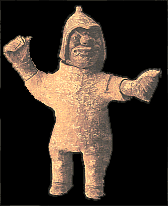“surrender and be enslaved, or die”
Review – Kelly – 12/12/96
“Treasures from Inner Mongolia, The Heritage of Genghis Khan” opened on the 23rd of November and runs until the 5th of January at the Canterbury Museum on Rolleston Avenue. Hours are 9.00am to 5.30pm daily, last entry 4.30pm.

This exhibition is very professionally run and effectively presented. It also provides information in a variety of mediums, including the traditional and more technologically advanced. After you have paid the less than modest entry fee, (Adults $12.00, Concessions $10.00, Children $5.00, Family $25.00), you are given an informative pamphlet and offered an “interactive audio commentary” which costs an additional $4.00. In the interests of journalistic accuracy I hired the audio gizmo, (which looks like an elongated cell-phone and works in a similar way to a tape player), and walked around with it feeling just a little bit self-conscious. It is worth it though, if you can afford the extra cost, because the aural information is fuller and more interesting than the text that accompanies the displays. There is also an excellent video at the beginning of the exhibition which focuses on the life and achievements of Genghis Khan, a name which apparently means “Emperor of Emperors, or “Oceanic Ruler”.
It is the legend associated with Genghis Khan which probably draws most people to this display. I was disappointed with the lack of vividness and character in this presentation of “The Heritage of Genghis Khan”, there was perhaps too much emphasis on the heritage, and too little on the conquering Mongolian armies and their illustrious leader. There are some colourful glimpses of the Mongolian lifestyle during Genghis Khan’s reign; the audio voice describes a highly efficient horse and rider communication system which involved riders travelling across the steppe for up to 10 days without provisions and without lighting a fire, surviving on blood drawn from an incision in their horse’s neck. However, most of the chronologically ordered displays focus on archaeological discoveries from along China’s northern frontier which illustrate the artistic traditions and culture of the various Mongolian tribes over 3 500 years. These are interesting, and some are quite beautiful, but they seem lifeless somehow.
The exhibition is fairly demanding of your concentration, there is almost too much information to absorb at once. Those who already have some knowledge of Asian history, Anthropology or Religious studies might get more from this exhibition than the uninformed. I definitely wouldn’t recommend bringing children under 12 along unless they are extremely interested in archaeology, and make sure you allow at least an hour and a half to have a look around and make the entry cost worthwhile.




